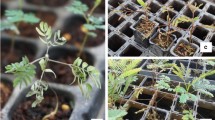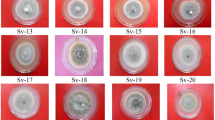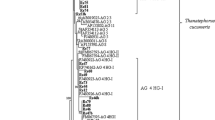Abstract
Eighteen isolates ofFusarium vasinfectum Atk., from different parts of the world,viz., India, Italy, the U.S.A. and the U.S.S.R. were compared for their morphological and cultural characters, and found to be different. Light induced the formation of a uniform orange pigmentation in the cultures regardless of their being pigmented or not under dark-incubation and this is possibly due to photoactivation. The isolates maintained the observed morphological characters over a period of two years, when grown on standard medium, incubated at constant temperature and under darkness, though subcultured repeatedly.
The isolates could be differentiated into three groups on the basis of their pathogenicity to two cotton speciesGossypium arboreum L. andG. hirsutum L. The Indian and Russian isolates were pathogenic toG. arboreum while the American and the Italian, toG. hirsutum. Four of the Indian isolates were, however, pathogenic to neither of the hosts. The wilt symptoms were different on the two hosts. The roots of the host plants were invaded by all the isolates under the present experimental conditions. There was no correlation between wilt percentage and percentage of roots invaded. The pathogenic potential of the isolates is, hence, not related to their ability to invade the host roots.
Similar content being viewed by others
References
Ajrekar, S. L. and Bal, D. V... “Observations on the wilt disease of cotton in Central Provinces,”Agric. J. India, 1921,16, 598–617.
Armstrong, G. M. and Armstrong, J. K. “A comparison of the host relationships of the American, Indian and Egyptian cotton-wilt Fusaria,”Int. Bot. Congr. 7th, 1950, 697.
Brown, W... “Studies in the genusFusarium. II. An analysis of factors which determine the growth-forms of certain strains,”Ann. Bot., 1925,39, 373–408.
Carlile, M. J... “A study of the factors influencing non-genetic variation in a strain ofFusarium oxysporum,”J. gen. Microbiol., 1956,14, 643–54.
Charudattan, R. and Kalyanasundaram, R. “Carrier hosts ofFusarium vasinfectum Atk.,”Phytopath. Z., 1966,55, 239–42.
Dharmarajulu, K... “A study of the pathological anatomy of the cotton plant in connection with the wilt disease,”Indian J. Agric. Sci., 1932,2, 293–313.
Fahmy, T... “TheFusarium disease (wilt) of cotton and its control,”Phytopathology, 1927,17, 749–67.
Garrett, S. D. ..Biology of Root-infecting Fungi, Cambridge Univ. Press, 1956.
Kalyanasundaram, R. .. “Soil conditions and wilt diseases in plants: Fungal wilts and changes in host metabolism,”Doctoral Thesis, University of Madras, 1953.
—————.. “Soil conditions and root diseases. XIII. Symptomatology ofFusarium wilt,”J. Indian bot. Soc., 1954,33, 329–37.
Kern, H... “Über die Beziehungen zwischen dem Alkaloidgehalt verschiedener Tomatensorten und ihrer Resistenz geganFusarium lycopersici,”Phytopath. Z., 1952,19, 351–82.
Kulkarni, G. S... “Studies in the wilt disease of cotton in the Bombay Presidency,”Indian J. Agric. Sci., 1934,4, 976–1045.
Maerz, A. and Paul, M. R...A Dictionary of Color, 2nd Edn., McGraw-Hill Book Co., Inc., New York, 1950.
Mundkur, B. B... “Resistance of American cottons toFusarium wilt in India,”Proc. Ind. Acad. Sci., 1936,3, 498–501.
Neal, D. C... “Cotton wilt: a pathological and physiological investigation,”Ann. Mo. bot. Gdn., 1927,14, 359–407.
Sanwal, B. D... “Investigations on the metabolism ofFusarium lycopersici Sacc. with the aid of radio active carbon,”Phytopath. Z., 1956,25, 333–84.
Sobek, O. K... “Physiological properties ofFusarium lycopersici andF. vasinfectum,”Phytopathology, 1952,42, 119–22.
Snyder, W. C. and Hansen, H. N. “The effect of light on taxonomic characters inFusarium,”Mycologia, 1941,33, 580–91.
Subramanian, C. V. .. “Soil conditions and wilt diseases in plants with special reference toFusarium vasinfectum on cotton,”Doctoral Thesis, University of Madras, 1947.
—————.. “Studies on South Indian Fusaria. I.Fusarium vasinfectum Atk., with a note on its varieties and forms”,Proc natn. Inst. Sci. India, 1952,18, 273–85.
Tippannavar, M. B. and Patil, S. V. “Retrospect and prospect of cotton cultivation in Bombay-Karnatak,”Indian Cott. Grow. Rev., 1952,6, 26–34.
Wiles, A. B... “Comparative reactions of certain cottons toFusarium andVerticillium wilts,”Phytopathology, 1963,53, 586–88.
Zachariah, A. T., Hansen, H. N. and Snyder, W. C. “The influence of environmental factors on cultural characters ofFusarium species,”Mycologia, 1966,48, 459–67.
Author information
Authors and Affiliations
Additional information
Communicated by Prof. Dr. T. S. Sadasivan, F.A.Sc.
Memoir No. 64 from the Centre for Advanced Study in Botany.
Part of the thesis of the author approved for the degree of Doctor of Philosophy by the University of Madras, 1967.
Rights and permissions
About this article
Cite this article
Charudattan, R. Studies on strains ofFusarium vasinfectum Atk.. Proc. Indian Acad. Sci. 70, 139–156 (1969). https://doi.org/10.1007/BF03052223
Issue Date:
DOI: https://doi.org/10.1007/BF03052223




